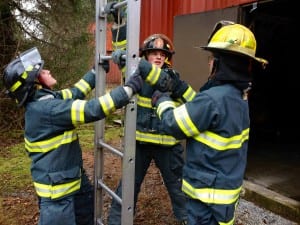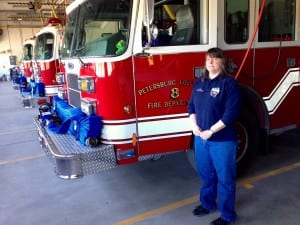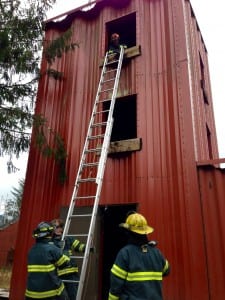
Lloyd Rice gets instructed by Dan Bird while Annette Wooton helps hold the ladder. Photo/Angela Denning
It’s a Saturday afternoon and a handful of fire fighters are at the Scow Bay fire station just outside of town learning to work with ladders: really big, metal ladders that just two people maneuver. There’s a chilly breeze in the air but the volunteers in full gear are working up a sweat.
The two manning the ladder are Annette Wooton who is furthering her training and Lloyd Rice who is just joining the volunteer team. Long-time volunteer Dan Bird is coaching them.
“So we’ll do the flat raise twice and we’ll do the beam raise twice,” Bird said. “This time we’re going to the third floor window.”
Back at the fire station in town, Sandy Dixon, sits in her office. She’s the only one in the building which isn’t unusual. She’s the Fire and EMS Director and just one of two paid workers in the borough department. Dixon oversees about 65 men and women that respond to fire, medical and search and rescue emergencies. Twenty-three are trained for fires and she says that’s not really enough.
“That doesn’t always mean 23 are available if we have a call so people are out of town, people are working and can’t get off their jobs, they’re sick, they have to be home with their kids,” Dixon said. “For whatever reason they’re doing something else.”
So, when an emergency call goes out, sometimes five to ten people respond. Dixon says the standard number for a house fire would be 15 to 20.
“So we do what we can do with the numbers that we have,” Dixon said.
This means that sometimes structures just have to burn. This happened one summer when there were only seven volunteers responding to a house fire. There weren’t enough of them to go inside the building so they concentrated on extinguishing the fire from the outside and prevented it from spreading to other structures. The home was a total loss.

Petersburg Borough’s Fire and EMS Director, Sandy Dixon, stands in the main fire station on Haugen Drive. Photo/Angela Denning
“So you just do the best you can do?” I asked.
“That’s exactly it,” Dixon said. “You do what you can do with what you have.”
The EMS side gets more than 200 calls a year, more than fire and search and rescue combined. EMS is also training new recruits this spring. They have four new people taking a starter course which will allow them to ride on an ambulance. But 45 hours of initial training doesn’t mean they’ll end up as volunteers. In a recent, similar class only three of eleven ended up becoming part of the team. Dixon says there are many reasons people don’t stick with it.
“Time commitment or they determined that EMS wasn’t for them which obviously you don’t know when you go to an emergency whether that’s really in your basket of tricks to do or enjoyment,” Dixon said, “and others moved away from town.”
The commitment requires getting certified through training. After that EMS volunteers sign up for 12 hour shifts although the department has gotten more lenient in recent years with occasional shorter times. EMS volunteers wear pagers. Fire volunteers are always on-call and respond when they can similar to search and rescue.
Having emergency responders in Petersburg isn’t really a choice. The borough has an ordinance that requires the department to provide emergency services, both fire and ems. The borough has tried to make it worthwhile through benefits like free medivac insurance, facility use, passes to the Rec Center, and a free dinner once a month.
Still, the shrinking volunteer trend continues. And Dixon says it’s a nationwide problem. When Dixon started out a few decades ago, she says, it wasn’t like this.

Fire Marshall, Ryan Welde, watches from a third story window as volunteer fire fighters practice raising the ladder. Photo/Angela Denning
“Volunteering was the way to go, I think,” Dixon said. “People were more dedicated to volunteering. And now people have to work two jobs or they have to stay with their families and other organizations with budgets being cut are requiring more volunteerism and so you’re just spread very thin.”
The current response teams can’t maintain forever. There are about five fire fighters that are over the age of 60. There are a few in EMS who say it’s their last time re-certifying.
“Cause they’ve been doing it for over 20 years,” Dixon said. “They’re tired. They don’t want to do it anymore.”
Back at the training building out of town Fire Marshall Ryan Welde looks down from the third story window. He watches the ladder action. Once it’s secured, leaning against the building he encourages Rice, the newbie, to climb.
For now–whether it’s just one new volunteer or 10– the Petersburg Fire Department will keep training them with the hope that they can continue serving the community year round.










